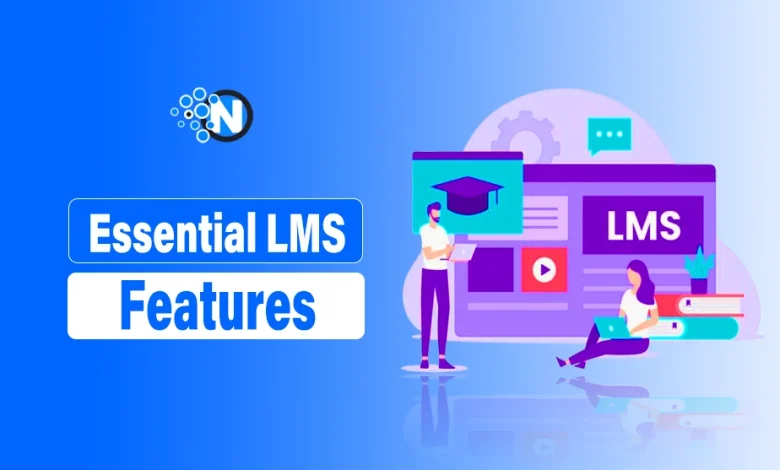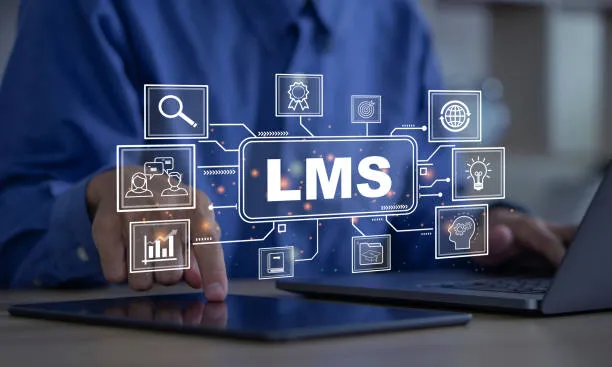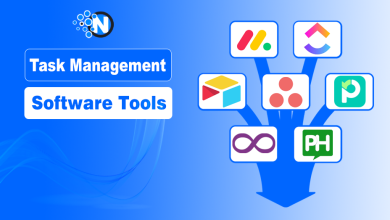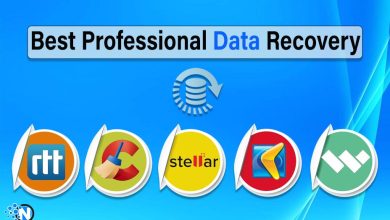Essential LMS (Learning Management System) Features for Enhanced Learning Efficiency

With changes happening quickly in the education sector, Learning Management Systems (LMS) impact the process of designing, providing and participating in learning. An LMS goes beyond storing digital content; it brings together teachers and learners, enables instant feedback, and fits the way people learn.
With so many options available, identifying which features truly matter can be a challenge.
Ready to find out what makes a learning management system truly shine?
In this blog post, I will explore the must-have LMS features that will transform your learning experience and help you create effective training programs.
Let’s start!
10 Best LMS Features You Can’t Afford to Miss

1. User-Friendly Interface
Learners or administrators will not adopt an LMS that is difficult to use. A clean, intuitive user interface is fundamental. Look for an LMS with a modern design that is easy to use, even for individuals who are not tech-savvy.
Leading Learning Management platforms / LMS offer customizable dashboards. These allow users to quickly see their progress, upcoming training courses, and important notifications. This feature alone can greatly boost learner engagement and completion rates for any training program.
A positive user experience reduces the learning curve for the LMS itself, allowing users to focus on the learning content rather than figuring out the system. The visual identity of the platform can often be customized to match your organization’s branding, creating a more cohesive feel. For a learning manager, a straightforward interface simplifies administrative tasks such as course creation and user management, making their job more efficient.
2. Mobile Learning Capabilities
In today’s fast-paced environment, mobile learning is not just a perk; it’s a necessity for effective employee training. A top-quality LMS should provide a seamless mobile experience. This allows learners to access courses and learning materials anytime, anywhere, on any mobile device.
Look for a responsive design that adjusts to various screen sizes. Offline access for learning without an internet connection is another valuable aspect. These features ensure your learners can continue their online training, whether they are on a lunch break or commuting, using their preferred mobile device.
Many learning management systems now offer a dedicated mobile app for an even more optimized experience. This capability is crucial for blended learning strategies and provides flexibility for various training scenarios, including sales training in the field or customer training at their convenience. The ability to deliver content effectively on a mobile device expands the reach of your learning portals.
3. Reporting and Analytics
Data is incredibly valuable for learning and development. The top LMS platforms have powerful reporting tools that show details beyond simply when a course is completed. It’s important to check the progress of learners, how engaged they are, what skills they lack and how well your training LMS is working.
You can use advanced analytics to spot learning trends and find out what impact your training courses have. The data helps you choose actions that will help you refine your training. A few LMS systems make use of AI to help learners predict what they are likely to face or succeed in when they begin a new learning activity.
You should also check if XAPI compliance is available, since it enables you to trace many kinds of learning experiences, no matter how different they are from traditional courses. The data collected is very useful for a learning manager trying to prove the value of learning programs. An LMS is very helpful for turning raw results into useful improvements for the learning program.
4. Personalized Learning Plans
Adopting a universal teaching method doesn’t support learning. A strong LMS needs to understand the needs and abilities of learners and it should give them a personalized learning course. Recommendations could be created by AI, depending on a learner’s recent progress, job duties or what might interest them.
Learners stay excited when they focus on the learning material that is most valuable to them. The way employees are assessed helps to boost both the information they take in and the training process itself. Using this method supports each learner’s rate and style of learning, making the process more enjoyable.
You can use learning paths for tasks like entering someone in the company, enhancing employee skills or training for sales positions. Making learning materials in modules that advance systematically pushes students to achieve certain competencies. This focus on individual development makes the training program more impactful.
5. Social Learning Tools
Learning is often a social activity. The best LMS features incorporate social learning tools that encourage collaboration and knowledge sharing among users. These may include discussion forums, peer-to-peer messaging, Q&A sections, or the ability to share and comment on learning content.
These features help create a sense of community within the LMS platform. They allow learners to benefit from each other’s experiences, insights, and collective problem-solving. It’s like having a virtual study group or a community of practice readily available, fostering collaborative learning.
Integrating social learning can transform a static learning experience into a dynamic one. It supports informal learning, where knowledge is exchanged organically. For many organizations, this enhances team cohesion and can accelerate the spread of best practices, especially for complex topics or skills development.
6. Gamification Elements
Education can be enjoyable rather than boring. Points, badges, leaderboards and virtual gifts can enhance basic training and make it more rewarding. They encourage us to do our best and seek attention which keeps students interested in their work.
Look for a platform that facilitates adding gamification tasks during online training. The best LMS platforms give users the option to customize different functions. This way, you can connect them with your company’s unique culture, the main goals of the training and the type of e-learning material.
Applying gamification effectively helps students complete more tasks and retain what they have learned. Such approaches help learners not to feel forcing when faced with mandatory compliance training. The main point is that gamification backs up the objectives of learning and avoids adding unnecessary distractions.
7. Content Creation and Management
Developing engaging learning content is fundamental for effective online learning. A good LMS should include a built-in authoring tool or seamlessly integrate with external ones, making it easy to create, update, and manage training courses. Look for features like drag-and-drop course builders, support for multimedia content formats, and the ability to import content from various sources.
Additionally, strong content management features are crucial. These help you organize, version, and update your learning materials efficiently, ensuring your learning content library is current and relevant. This functionality is vital for an editorial team or learning manager responsible for the quality and accuracy of elearning content.
The ability to handle various content formats, including SCORM, xAPI, videos, and documents, provides flexibility. An LMS helps streamline the entire content lifecycle, from initial creation to delivery and eventual archiving. This makes it easier to create learning experiences that are rich and varied.
8. Integration Capabilities
Your learning management system should not operate in isolation. It needs to connect smoothly with your other business systems. The best LMS platforms offer extensive integration capabilities with HR systems, talent management software, CRM systems, video conferencing tools, and other applications your organization relies on.
Look for an LMS with great API support and pre-built LMS integrations with popular business tools, including options for single sign-on (SSO). This ensures your LMS becomes a central, interconnected part of your overall technology and learning ecosystem. Seamless integration simplifies user management and data synchronization, reducing manual admin tasks.
Integrating an LMS can automate data flow, for instance, syncing employee data from an HRIS or feeding training completion data into performance management systems. This makes the LMS software more powerful and efficient. For specialized needs like sales training, integration with CRM systems can provide valuable context and tracking.
9. Automated Admin Tasks
Administrative work associated with managing training programs can be very time-consuming. Automation is one of the most valuable LMS features. A good LMS should automate repetitive admin tasks like course enrollment, sending reminders, progress tracking, and generating certificates upon completion.
Automated workflows not only save considerable time for the learning manager and administrators but also reduce the risk of human error. This enables the L&D team to focus on more strategic activities, such as designing effective learning experiences and evaluating the impact of training. It’s essential for efficiently managing a growing number of learners and courses.
The ability to automate training administration is key to scaling your learning initiatives. This can streamline training logistics from assigning learning paths to tracking progress for compliance training. A cloud-based LMS often excels in providing these automated features with continuous updates.
10. Compliance Training Support
For many organizations, especially those in regulated industries, compliance training is a critical requirement. The best LMS platforms offer features specifically built to support compliance needs. This includes the ability to meticulously track completions, send automated reminders for due dates or recertifications, and generate detailed reports for audits.
Look for an LMS that allows you to set expiration dates for certifications and automatically enrolls learners in necessary refresher training courses. Robust version control for compliance content is also important. These features can save significant time and effort when it comes to maintaining and proving compliance.
Effective compliance training management within an LMS helps mitigate risks and ensures the workforce adheres to legal and regulatory standards. The system should provide clear audit trails. This makes the entire process of managing and reporting on mandatory training much simpler and more reliable for any learning program.
Considering Your LMS Provider and Options
Picking the proper learning management system isn’t just about listing features; it’s about finding the right LMS service. First, identify what you want to accomplish in your organization by choosing between training programs for employees, customers, sales or compliance. This will allow you to select and set up the most important LMS features.
Review different LMS companies by reading case studies and what users have to say about them. Remember that the price structure may work differently – some charge per employee, some by active users and others by tiered licenses. Be sure to review what each pricing model covers so that you don’t face any surprise expenses.
Check the quality of both customer support and customer service from the company, as it will affect your future success with using the LMS. Picking a vendor who offers a free trial is a wise move, as it allows you to check the user interface, main abilities and how easy it is to use. By choosing a talented LMS provider, you receive support for your learning needs and help with scheduling and automating many types of training.
Conclusion
A learning management system with the best features makes a big difference in your learning and development journey. Metrics, mobile availability, custom learning tracks and an easy-to-use interface are combined correctly in these platforms. They assist in making the learning environment in your organization more powerful and effective.
Your most relevant LMS features are the ones that respond precisely to your company’s needs, learning targets, and learner requirements. Assess your needs for an LMS software to support your training, for example, to create specific courses or administer large learning events. Determining the features that will dominate the learning experience and address organizational needs should be your primary concern.



